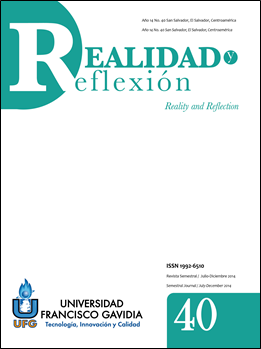The use of mobile phones in the public education system in El Salvador: Educational Resource or educational distraction?
DOI:
https://doi.org/10.5377/ryr.v40i0.2752Keywords:
educational technology, educational innovations, teaching methodsAbstract
This article represents the theoretical systematization of the study entitled The use of mobile phones in the public education system: Educational Resource or teaching resource distractor? This article allows the pedagogical approach on the impact that the use of these devices in Salvadoran educational system contexts. The study was conducted in 69 educational institutions of the 14 departments of El Salvador, thereby generating an analytical framework in which the movile appears to occupy the role of great distractor of teaching and learning. The study was conducted from 6 to 23 May 2014, at which time a thousand 384 junior and high school students and 200 high school teachers from across the country were surveyed.
The study is a relationship in which the dichotomy of cell phone use in Salvadoran schools, can assess whether this technological artifact is actually a teaching resource for educational use or a mere distraction that reveals several tensions or problems relationship between teachers and students because of the appearance of this device; all within the framework of educational postmodernism, in which the cell phone takes a leading role in the Salvadoran classrooms.
Realidad y Reflexión Año 14, N° 40, 2014
Downloads
9232
Downloads
Published
How to Cite
Issue
Section
License
© Universidad Francisco Gavidia
Instituto de Ciencia, Tecnología e Innovación (ICTI)
Reality and Reflection
The content and opinions expressed in the publication are the responsibility of the authors of the published articles. The authors assign the publishing and publishing rights, in printed and digital version, to the Universidad Francisco Gavidia.
Proof of originality and assignment of publication rights
The authors must sign a certificate in which they indicate that the text presented for publication is original, unpublished and that it has not been sent for review in another academic publication; In turn, the authors assign the rights of publication and publication to Francisco Gavidia University. The format of this record will be sent through the emails: editores@ufg.edu.sv and jlozano@ufg.edu.sv
The journal Reality and Reflection is housed in the institutional dissemination platforms (web page and in the repository), as well as in databases and other pages of scientific dissemination. The publications of the Francisco Gavidia University are subject to the Salvadoran copyright law, contemplated in the Intellectual Property Law https://www.asamblea.gob.sv/
The content of the work is the sole responsibility of the author, therefore, if for any reason or reason, direct or indirect, the Editor is obliged to pay any compensation to a third party derived from the work of the author, whether it is established in a transaction, agreement or final or enforceable judicial sentence, the Editor may repeat against the Author for the total amount of compensation, plus adjustments, interests and costs that correspond.
It will be the obligation of the UFG to grant five copies of the publication which will be delivered at the UFG Editores headquarters in San Salvador.

